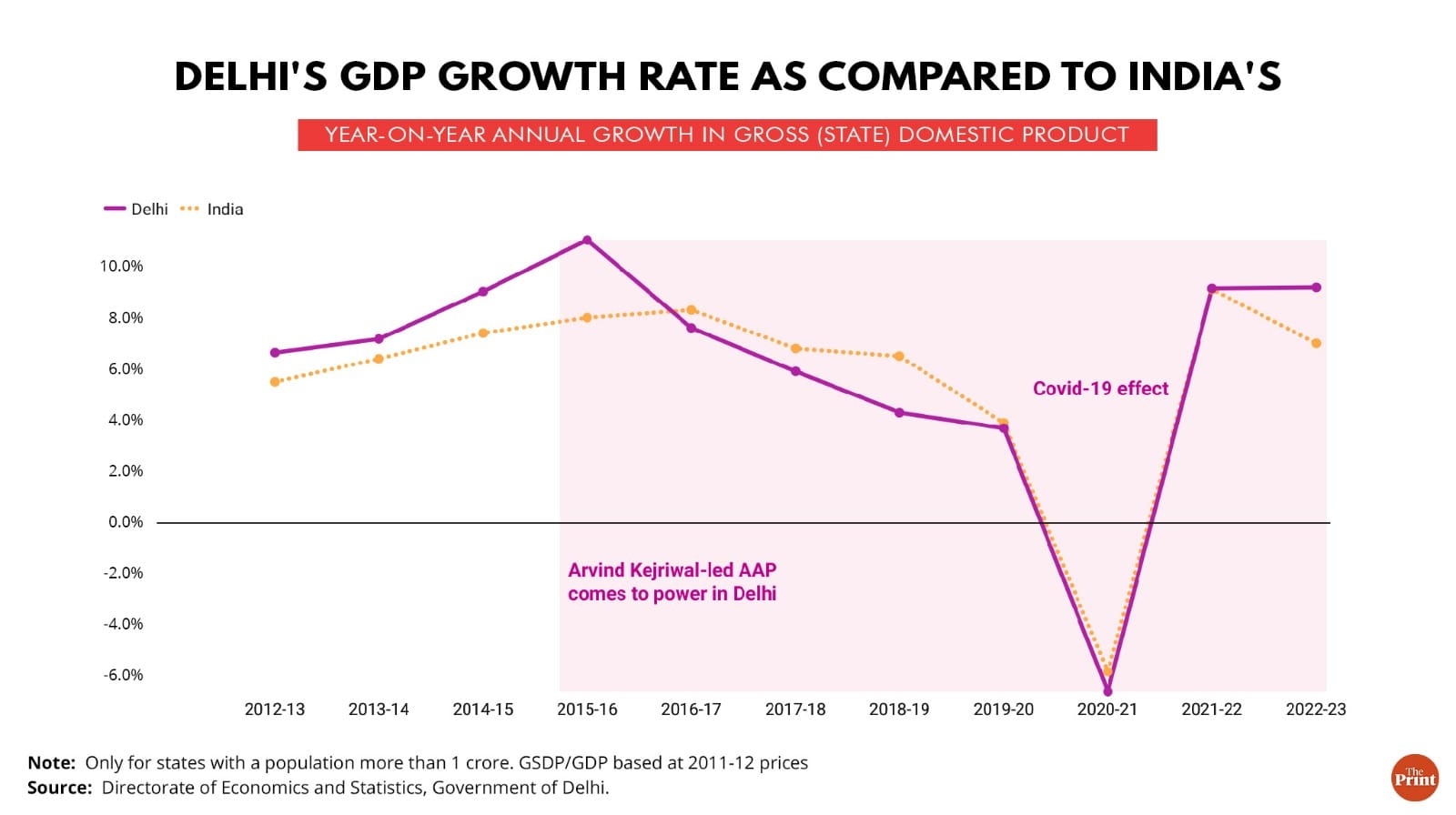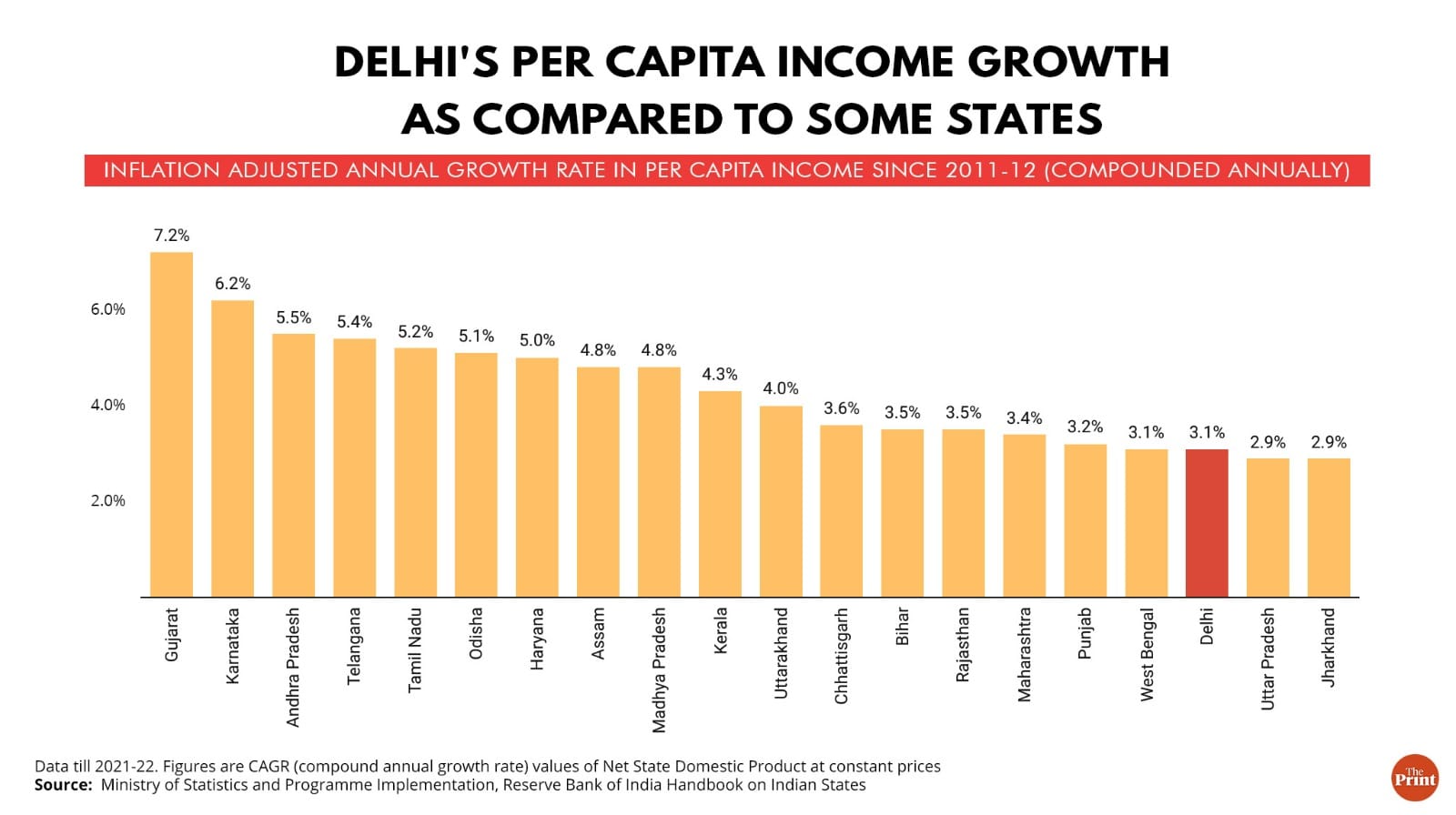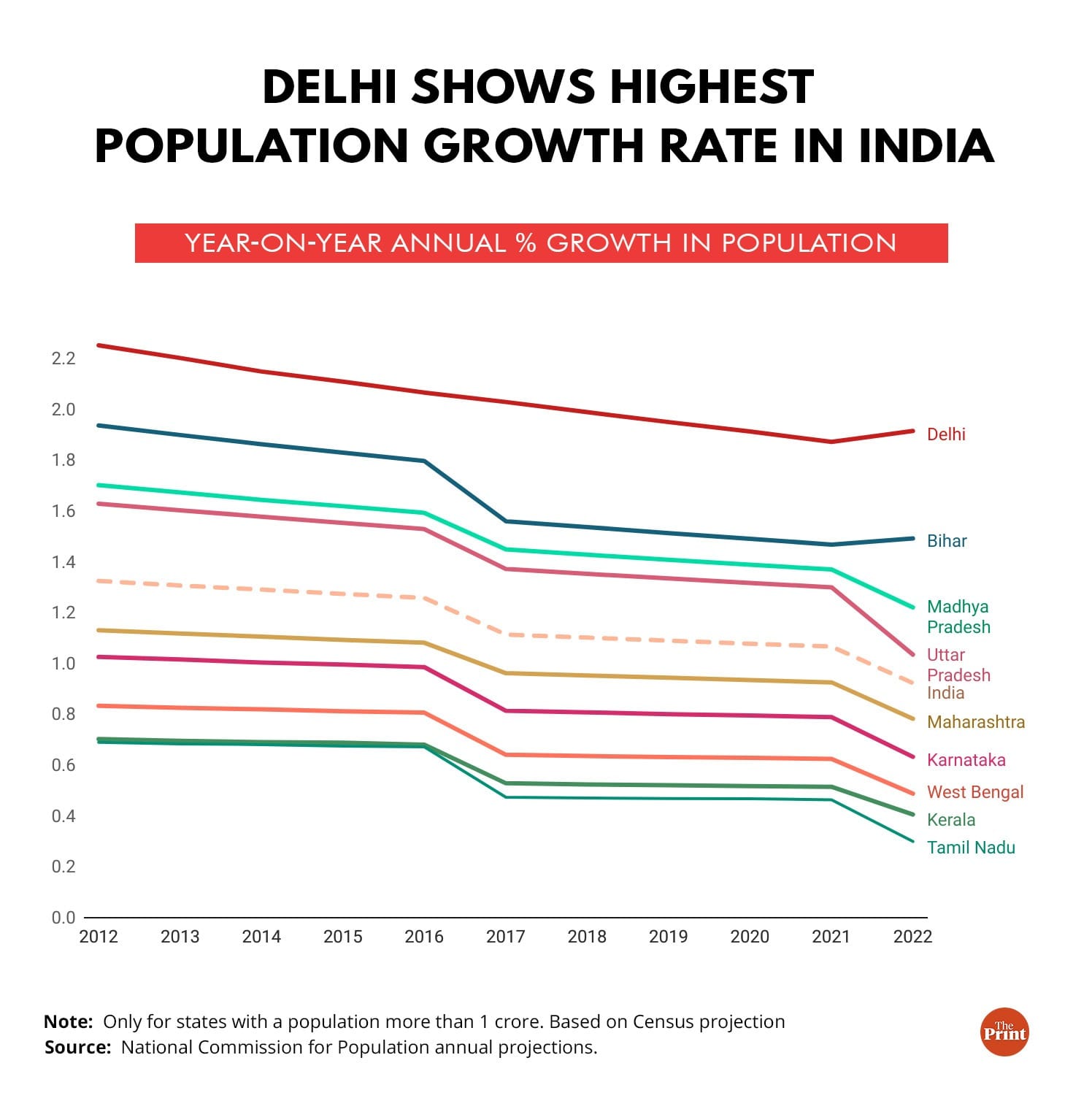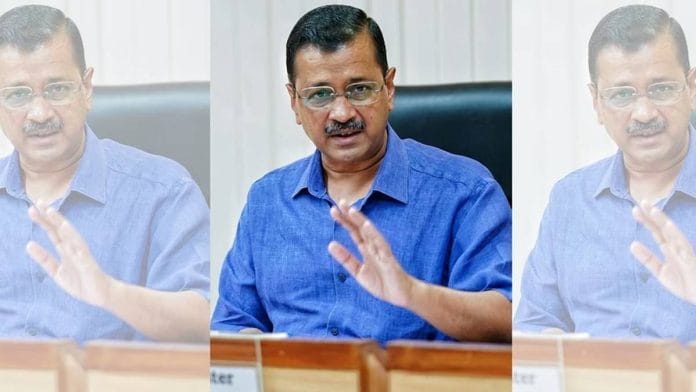New Delhi: Although Delhi, a union territory (UT) with roughly two crore inhabitants according to the 2021-22 population projections, has the highest per capita income in the country among all states and UTs, the growth in this income over the past few years has been relatively sluggish, ThePrint has found.
The 2022-23 year was an exception, when Delhi’s economy showed a faster recovery from the Covid pandemic-induced slowdown of the previous years as compared to the national average, according to the Economic Survey of Delhi 2022-23 tabled in the Delhi Assembly, earlier this year. In the last financial year, Delhi’s gross state domestic product (GSDP) grew at 9.18 per cent, while India’s gross domestic product (GDP) grew by 7 per cent. Pegged to its population, Delhi’s per capita income rose by 7.54 per cent in the 2022-23 financial year, a little above the 5.98 per cent growth India reported according to the same parameter.
On the whole, however, while Delhi Chief Minister Arvind Kejriwal said earlier this week that Delhi’s pace of development hasn’t gone down in the past eight years — since his government came to power here — it’s not been reflected in the growth of Delhi’s per capita income.
Since 2015, when Delhi elected the Arvind Kejriwal-led Aam Aadmi Party to power, the growth in its inflation-adjusted per capita income has averaged at an annual 3.02 per cent till 2022-23, as against the national annual average growth rate of 3.8 per cent.
Before that Delhi’s per capita income had been growing at a faster pace than India’s average. In 2012-13, Delhi’s per capita income grew by 3.9 per cent, while the all-India figure grew by 3.27 per cent. Between 2013-14 and 2014-15, the gap between Delhi’s growth and that of the all-India average was less than 1 per cent. The gap widened after 2015-16.
In the 10 years between 2012-13 and 2022-23, Delhi’s per capita income has grown at an average rate of 3.5 per cent per annum (compounded annually), against the national average of 4.12 per cent.

While it is to be expected that any state or UT with a high per capita income level will likely see slower growth than those with lower per capita incomes, that base effect does not fully explain why the growth in Delhi has been so slow.
Experts ThePrint spoke to said Delhi’s low growth in per capita income is a combined effect of multiple issues, but the base population remains the biggest challenge.
According to Manish Gupta, associate professor at the National Institute of Public Finance and Policy (NIPFP), New Delhi, the city-state has a high population growth, which impedes its growth in per capita incomes.
“A higher population growth means more and more people get added to Delhi’s denominator. So even if Delhi’s GSDP grows fast, a high and rising population growth pulls down the rate of growth on a per capita basis,” he explained.
ThePrint analysed data over a 10-year period, between 2011-12 and 2021-22, to put Delhi’s growth in perspective of that seen by some other states. ThePrint compared Delhi’s data with that of states and not UTs despite Delhi being an union territory, because its population makes it comparable to states.
Also read: Make it easier for nominees & heirs to access money left to them, RBI-appointed panel suggests
State-wise rankings
Having a lower-than-national-average growth means there will be multiple states doing much better than Delhi in terms of growth in per capita incomes.
ThePrint calculated the average growth rates in per capita incomes, in all states with more than 1 crore population, over a 10-year period, to find Delhi’s pace of growth is better only to Jharkhand and Uttar Pradesh, while it equaled that of West Bengal
Since many states have not yet released their latest state domestic product (SDP) figures, the analysis is limited to the period 2011-12 to 2021-22, the first year of recovery from the Covid pandemic-induced slowdown.
In these 10 years, Delhi’s per capita income grew by an average 3.1 per cent (the above figures of 3.5 per cent are for 2012-13 to 2022-23). Jharkhand and Uttar Pradesh, with populations of 3.89 crores and 23.3 crores respectively, according to the National Commission on Population’s 2022 projections, showed a growth of 2.9 per cent.

Gujarat, with a population of roughly 7 crores, saw the highest growth in per capita income in India during this period, 7.2 per cent per annum (compounded annually).
Gujarat is followed by Karnataka and Andhra Pradesh with a growth rate of 6.2 per cent and 5.5 per cent, respectively. While Karnataka has a population of 6.7 crores, for Andhra Pradesh it is 5.2 crores.
With a population of 3.8 crores, Telangana, meanwhile, reported a 5.4 per cent per annum growth in its per capita income between 2011-12 and 2021-22.
Delhi’s neighbour, Haryana, which has a population of 2.9 crores, also saw a growth of 5 per cent per annum in its per capita income, compounded annually. (Check above graph for more.)
Why slow growth?
The Delhi government uses the latest population estimates provided by the National Commission on Population as its base.
ThePrint, however, divided the absolute net state domestic product (NSDP) by the per capita income, and found that Delhi has the fastest growth in population across all states with populations of more than 1 crore population.
Delhi had about 1.8 crore residents in 2014-15 according to Census figures, which was projected to be 2.1 crore by 2021-22, a jump of about 2 per cent per annum, compounded annually.
Despite a low fertility rate (number of children born per woman) of 1.4, Delhi’s population is even bigger than that of Bihar, which has the highest fertility rate in the country of about three.

This means that Delhi’s population explosion is likely to have come through migration. A high per capita income level attracts people from across the country, which then boosts the population numbers, which in turn slows the growth of that per capita income.
“When a tiny city like Delhi earns the highest per capita income in the country, it attracts more and more people who come here in the pursuit of earning,” said economist Santosh Mehrotra of Jawaharlal Nehru University in Delhi. “But what does that signify? It simply means that we do not have growth in the parts of the country where these migrants are coming from. So this problem is likely to persist, not because Delhi does better, but other states are not doing well.”
Mehrotra added that, apart from the population growth, the paucity of land and its poor management also contributes towards the limited growth Delhi can witness.
“In the absence of affordable land, industries spread out in neighbouring towns and states and high-valued services have long shifted to its peripheries in Gurugram, Noida, Faridabad etc, so Delhi also loses out big on scope of expansion,” he explained.
(Edited by Poulomi Banerjee)
Also read: Is Gehlot destroying Rajasthan’s economy through freebies? Data shows this isn’t the case






